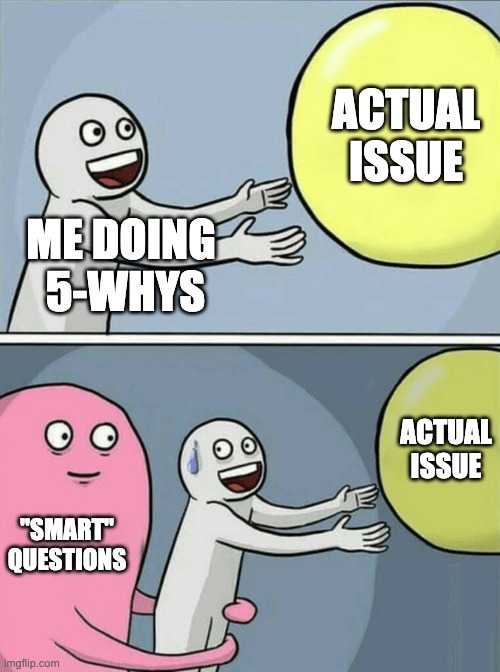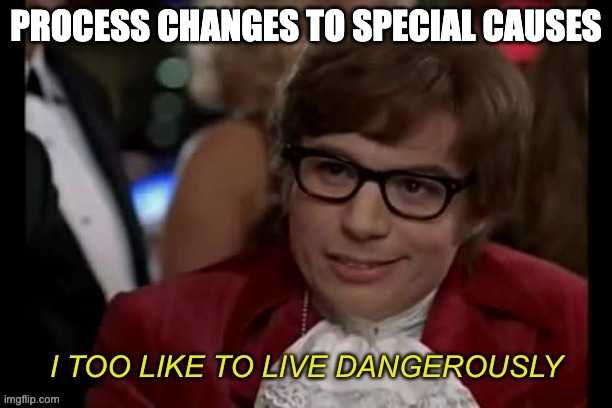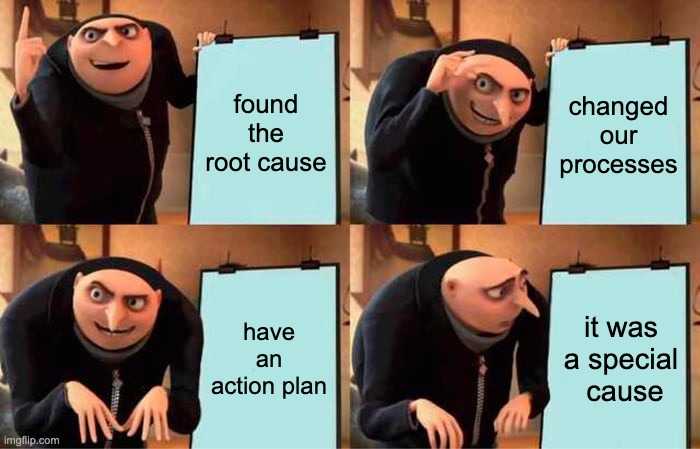What is 5-Why for Root Cause Analysis?
The 5-Whys technique originates from the Toyota Production System and is commonly used in manufacturing and software development. It aims to uncover patters and issues in processes, prevent from jumping to conclusions and foster the culture of continuous improvement. The allure of the 5-Whys method lies in its simplicity and potential effectiveness when used correctly and along with other tools and techniques.
However, it's simplicity can be deceptive. Revolving around the relentless pursuit of "why", it may get us in the murky depths of root cause analysis, knee-deep in irrelevant action items and wrong conclusions. This blog post will cover three common mistakes people make when performing the 5-Whys exercise to troubleshoot issues.
There are countless ways to do things wrong, but I felt compelled to focus on three specific ones that recently irritated me and motivated me to write this blog post. Channelling my mild annoyance, so to speak.
Smart Questions — The Art of Faking Wisdom

In many organizations, particularly those with layers of middle management, there's a prevalent practice of "Asking Smart Questions." This approach involves posing seemingly smart inquiries in a group setting, not so much to seek answers but as a subtle strategy to establish control. The underlying aim is for the bold and fearless leader to underscore their significance, authority, and higher status within the team. This behaviour stems from a cultural expectation that active participation and contribution during meetings are indicative of engagement, teamwork, and professional dedication.
Envision yourself in the shoes of a manager compelled to ask those "smart questions", amidst a group more versed in the subject. Faced with the self-imposed pressure to make a meaningful contribution, what do you do? Instinctively, you might find yourself hastily picking at the most accessible ideas (even if they're slightly off the mark), driven by the fear of being left out. This tendency, aimed more at asserting your presence than offering substantial input, can unintentionally lead the discussion astray.

To distinguish "smart" questions from actually smart questions, do a quick triage using these two heuristics:
- Smart questions typically attempt to narrow things down by questioning one cause-effect link at a time. On the other hand, "smart" questions ambiguously mention a relevant keyword, like "have we thought of [keyword]?" or "what about the [keyword]?".
- When smart questions pivot or branch out the discussion, it's often straightforward to trace the link between ideas and understand the progression of the logical argument — how we arrived at this point from a different starting place. On the other hand, "smart questions" more resemble abstract expressionist paintings of Jackson Pollock — lots of random splashes.
Thinking, Fast and Furious
In the quest for depth and understanding, the 5-Whys requires not just curiosity and knowledge of the subject, but a significant level of focus. I'm not saying that you have to get in the state of flow as identified by psychologist Mihaly Csikszentmihalyi, where an individual achieves complete immersion and engagement in an activity. But getting to a certain level of concentration and doing the homework is crucial for producing meaningful outcomes.
The investigator needs to write down and share his thoughts with the group beforehand, and ensure that every participant finds time to think deeply about the issue before the meeting. What often happens instead is people treat this as a checkbox activity, come unprepared, read the document in the meeting where the discussion should happen... and resort to "smart questions".
Systemic changes because of special causes
Now this one is a particularly dangerous mistake. Let's dive right in!
There are two types of issues: Issues that have special causes, and issues that have common causes. Understanding the difference between common and special causes in statistical management is key. Common causes are the usual, historical, quantifiable variation in a system, while special causes are unusual, not previously observed, non-quantifiable, unpredictable variation.
It's the difference between being a careless slob (common cause of a lot of things) and just having bad luck, force majeure, an act of God on the day when the incident occurred (special cause).

Statistical management is based on recognizing that there is variation in all processes and that managing this variation is key to improving quality and performance. You can read more about this in Deming's magnificent book Out of the Crisis.
This concept was central to the work of W. Edwards Deming and Walter A. Shewhart, who played pivotal roles in Japan's post-war industrial revival and influenced the Toyota Production System's efficiency. Deming, in particular, emphasized that reacting based on a one-off, special cause — a mistake he termed as "tampering" — can actually backfire: Changing a process in a reaction to a special cause could lead to even more variation and ultimately to even bigger SNAFU. This insight is fundamental to continuous improvement and Lean practices, highlighting the importance of discerning statistical noise from problems in a process.

The 3-Whys of 5-Whys limitations
To wrap up, if you avoid these three pitfalls you will definitely get a better rate of success with the 5-Whys technique. However, it still comes with limitations and caveats:
- In enterprise, siloed environments, the group may not have sufficient knowledge to get to the root cause. It may happen that the investigators will classify the issue at hand as a special cause. Special, like a snowflake. And will stop right there. But the company gets a lot of these unique snowflakes because the common cause is in the environment that creates such a variation of snowflakes and incidents.
- There is a "storm" in "brainstorm" for a reason. It's a highly creative but highly volatile process. Which means that the outcomes of a 5-Whys exercise are not very reproducible, i.e. another group of people or even the same people can come to a very different set of conclusions when investigating the same incident.
- Failures in complex systems rarely (never) have a single root cause. You should probably look at an aggregation of multiple factors. Complex systems usually have multiple layers of defence that are not penetrable by a single root cause. Use Fishbone diagram instead.
Having said that, don't discard the 5-Whys as a technique or a mental model, just use it wisely.